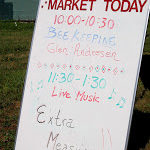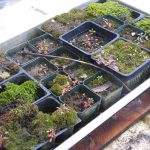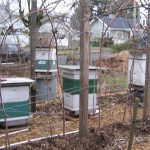 The first post in this series covered the roles of different bees in the colony. The second post in this series talked about reproduction, swarming and environmental needs of a colony. This final post will focus on equipment needed to start keeping bees in the city and potential disease.
The first post in this series covered the roles of different bees in the colony. The second post in this series talked about reproduction, swarming and environmental needs of a colony. This final post will focus on equipment needed to start keeping bees in the city and potential disease.
Glen Andresen advised that a love of nature and a love of puttering is a good personality fit for keeping bees. Although you can build your own hive, he recommends to buy new equipment when you are starting out. If you find used equipment, ensure it has not been used by diseased bees. Keep in mind there are a hundred different ways to do everything, so this is how Glen keeps bees and what he recommended for us.
Hive Boxes
Majority of the bees will be confined to the bottom two boxes, or “deep” boxes often referred to as brood boxes. There are a few different options with the brood box, but Glen recommends the deep 9 5/8″, which can get up to 80-90 pounds when filled with honey. We wouldn’t be harvesting from this box though. This is sort of the permanent dwelling for the bees. The honey they fill these two boxes with will feed them through the long winter.
Glen uses “western” boxes, or ones that are 6 1/4″, as his “supers”. A super is an addition box you place on top of the brood boxes that the bees fill with excess honey. They don’t live in these boxes, as they have enough room down below in the two large brood boxes. The supers are smaller and easier to manage when harvesting honey. As one fills up, you simple add a new one on top, making a stack. Eventually you could have two brood boxes, stacked with 1-5 supers on top.
If you are assembling your boxes, always use glue and nails. They get very heavy when filled with honey and using both ensures a strong build.
Clothing
It is recommended to buy a full body harvesting suit to prevent stings from the bees. Although they can be mellow creatures, they will start become stressed in late summer when there are fewer pollen sources. When you are out there harvesting honey, they may be more apt to sting.
Gloves are also highly recommended and come with either areas of netting or solid cloth. Every beekeeper has their preference on equipment, but Glen prefers the solid cloth. He has been stung too many times by a bee sitting on the netting. When he moves his hand and squishes them, without having seen them, he gets stung.
It’s a hot business being out in the summer sunshine unloading super boxes weighted down with honey. Netting can be desirable for air circulation, but at least you know the trade off is more possibly stings.
Other Equipment
A queen excluder is something you place between the two brood boxes and the supers on top that are intended for excess honey. The queen, being larger, cannot fit through the excluder, but the worker bees can. First, let the work bees “draw out” the supers, meaning let them make cells/comb ready for eggs. Then put in the excluder so the queen can’t go up there to lay eggs.
The benefit of the excluder is that now the queen will stay safely in the bottom two brood boxes. The worst thing you could do when harvesting honey is slide a frame back into place and accidentally squish the queen – eventually killing your colony. With her safely in the bottom, she can keep laying eggs while the excess honey can keep filling the upper super boxes.
Harvesting
Before you begin harvesting honey, take off all of the supers. Add an empty super with a “trap screen” and stack the full supers on top. You now have two brood boxes, an empty super, a trap screen, and full supers on top. As the worker bees go down from the full supers into the brood boxes to “check in” with the colony, they cannot move back up through the trap screen. It’s a one way only, hence they get trapped to the boxes underneath.
This allows you to harvest the full supers without disturbing the bees as much, since it will take about a day for all the bees to be out of the full supers. All of the excess bees can have enough room with the empty super and it’s less stress for everyone. You can add a couple new supers and remove the trap screen, allowing them to keep busy filling the empty supers with honey. And it gives you plenty of time to let the honey drain out of the full supers.
I can’t imagine what a sticky mess this must be! Thinking about two or three full supers sitting in my kitchen, extracting the honey by hand with a scrapper into big buckets… And all the while the bees are outside filling up new supers.
At the end of the summer, all of the supers will come off. The honey season is over and it’s time for the bees to be done working.
Winter and Disease
To cut down on disease, freeze your supers for 24 hours before winter storage. This will kill any wax moth larvae and other pests. Clean 20-30% of your frames a year, to keep disease down and prevent old cells from getting too narrow.
Glen uses a screened bottom board instead of solid wood, which can be left on year round. There is not a strong draft since this is on the bottom of the brood boxes, but it does allow some good ventilation. When mites attached themselves to the bees, they will fall off and out of the tray, instead of onto a solid floor still within the hive. Try to ensure there are never openings on opposite sides of the boxes, for entering/exiting, as this will create a draft running through the colony.
Their numbers will decline naturally in the winter because they do not need as many worker bees with no pollen to harvest. They could be 80,000 strong in the summer, with only 15,000 overwintering at minimum. The brood boxes may get light in the winter, which means they have eaten all of their stored honey.
Glen will then add a jar with 2 parts sugar and 1 part water to make syrup for the bees to live off of. The jar has small holes in it, so water doesn’t drip out but the bees can drink. This isn’t always necessary, but it’s important to keep an eye on them in the winter months in case they need the assistance.
Conclusion and Resources
I learned a lot in Glen’s four-hour class, but I feel like there is still a lot of figure out. And maybe I’m just the kinda girl that likes to have a book on hand with way more detail than is needed. Teaching a class on how to keep chickens in the city seems a lot easier than bees, but that is because bees are so complicated and interesting! Glen can be reached via email at glen@pacifier.com to learn about any upcoming classes he may still have openings for. They are typically held in the spring.
Locally, Ruhl Bee Supply seems to be the only place in the Portland area for buying equipment. However, there are tons of catalogs out there that you can buy equipment from as well. I would imagine Ruhl would be a great on-going resource as well for local beekeepers who have questions or problems along the way.
There is also the local Oregon Beekeeping Association that would be a great resource for people starting out or wanting to learn more.
I’m very excited to get into the sticky, fun mess of keeping bees!




 Upgrade your hanging basket game!
Upgrade your hanging basket game!  Here’s
Here’s

 This cluster was about the siz
This cluster was about the siz




 I start with a
I start with a

Another great post explaining the complicated subject of beekeeping. Thanks. I suspect beekeeping is not so difficult once one gets some experience at it. Having the right equipment and following all the steps probably becomes second nature. It would still be hard work but probably not be as mentally taxing as it seems to a novice.
If you need access to a centrifuge, Zenger has one and I believe it’s available for folks from the neighborhood to use.
We were listening to an interesting Rudolph Steiner lecture the other day about bees. He pretty much predicted the current problem with colony collapse disorder…claiming that problems would arise from the (then new) implementation of the classic square hive system that everyone seems to use today. His opinion was that bees are circular/spiraling in nature and square homes disrupt their patterns.
Note that Bee Thinking (http://www.beethinking.com) also sells beekeeping supplies in Portland (1551 SE Poplar Ave, right behind Castagna Cafe on Hawthorne).